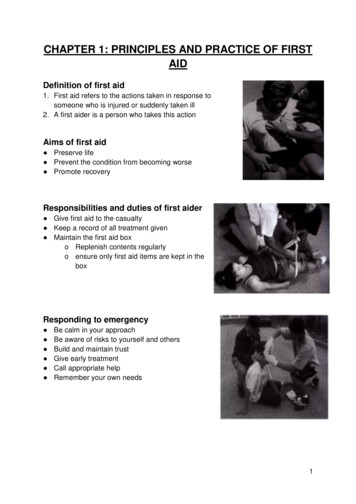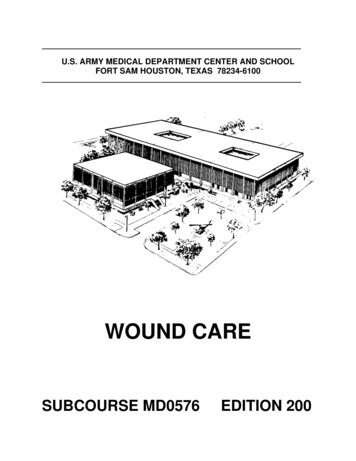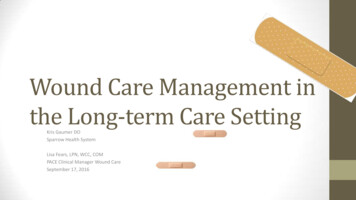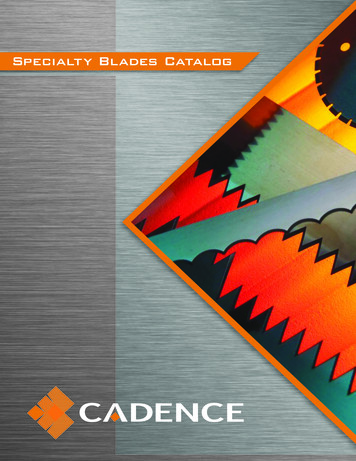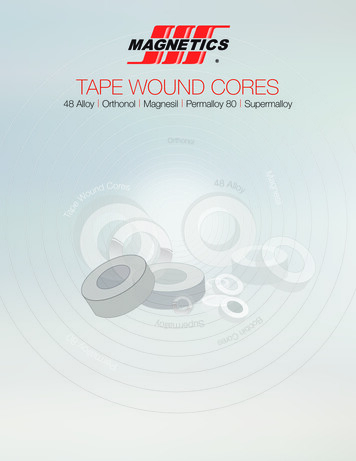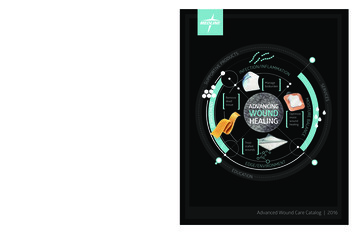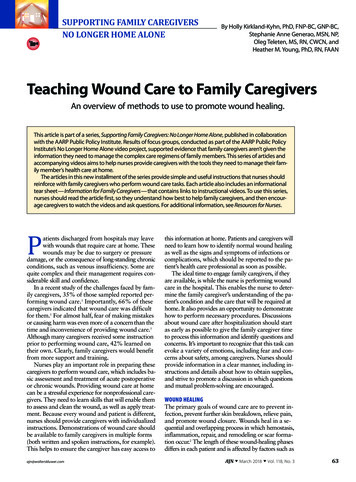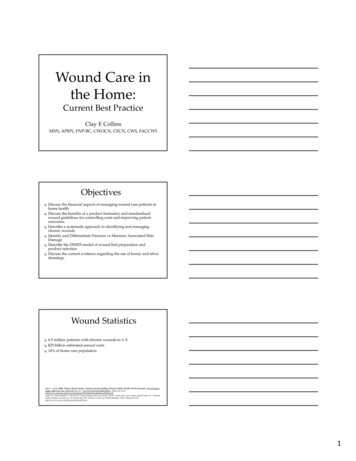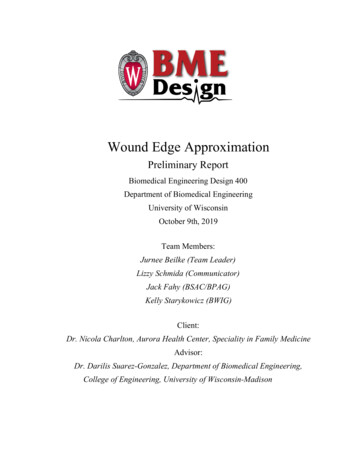
Transcription
Wound Edge ApproximationPreliminary ReportBiomedical Engineering Design 400Department of Biomedical EngineeringUniversity of WisconsinOctober 9th, 2019Team Members:Jurnee Beilke (Team Leader)Lizzy Schmida (Communicator)Jack Fahy (BSAC/BPAG)Kelly Starykowicz (BWIG)Client:Dr. Nicola Charlton, Aurora Health Center, Speciality in Family MedicineAdvisor:Dr. Darilis Suarez-Gonzalez, Department of Biomedical Engineering,College of Engineering, University of Wisconsin-Madison
AbstractEach year, 6 million laceration cases are treated in emergency departments. Withlacerations larger than 1-2 cm, skin tensions tend to pull the wound edges apart, making repairdifficult for clinicians in office settings, urgent care clinics, and emergency departments.Clinicians often need to involve a second individual to approximate wound edges while thewound is closed with sutures or tissue adhesive. Currently, no device exists on the market in theUnited States designed solely to approximate wound edges. There are wound closure systemsthat have two primary functions: approximate the wound edges, and seal the wound. A devicewill be designed to accurately and repeatedly approximate wound edges allowing the clinicianuse of both hands during wound repair. The proposed device is a small rectangular metal framethat consists of two long sides either covered in silicone or with an attached adhesive that willlay along the edges of the wound and create a stable contact point with the skin. The two shortsides of the frame will have a gear system that will allow shortening of the device’s edges tofacilitate wound approximation. Fabrication will be done using the MakerSpace and TEAM Labto create a functional prototype. Testing will include a stress concentration analysis usingSolidWorks and wound edge approximation with a suture kit.
Abstract2Introduction4Motivation4Existing Devices4Problem Statement7BackgroundBackground Research88Client Information11Design Specifications12Preliminary Designs12Bow-Shaped Design12Hook and Loop Design13Barrette Design14Rectangle Design14Preliminary Design EvaluationDesign Evaluations1517The Bow-Shaped Design17The Hook & Loop Design18The Barrette Design18The Rectangle Design18Proposed Final References22Appendix A: Product Design Specification24Appendix B: Design Drawing30
IntroductionMotivationOver 6 million laceration cases are treated in emergency departments each year; duringsuch repairs, skin tension pulls the wound apart while the clinician is attempting to approximatethe wound edges [1]. Repair is therefore difficult, and imperfect approximation can lead toscarring and poor healing of the wound. This problem is often solved within operating rooms withwound closure systems for large wounds since multiple physicians can assist in woundapproximation and closure. However, it poses a challenge for physicians in emergency rooms,urgent care clinics, and office settings when repairs on small wounds need to be completedquickly by one individual. Currently, there are a lack of devices on the market that function solelyfor wound edge approximation; many healthcare professionals rely on a second person toapproximate the wound edges together or attempt to use forceps to hold the wound while it issutured or glued. Surgical tools such as forceps are not designed to approximate wound edges, forthey require at least one of the clinician's hands to function during the wound approximation,leaving only one free hand to partake in the wound closure. Forceps and other surgical tools mayalso pinch the skin and be uncomfortable to the patient. Therefore, there is a gap in the market fora device that allows accurate and quick wound approximation while functioning autonomouslyonce placed on the skin to provide the clinician with both hands to participate in wound closure.Existing DevicesSeveral products exist in the market known as wound closure systems that function toapproximate wound edges and close the wound for healing. The apparatus the team designswill only possess one of these functions: approximating wound edges. The device will notneed to include a wound closure function, for the wound will be closed primarily with tissueadhesives or sutures. The wound closure systems currently available include the following:DermaClip : U.S. Pat. Nos. 8,157,839, 9,028,529, 9,301,760, and 9,603,596The DermaClip is a skin closure device that allows for fast closure of skin surfacewounds (Fig. 1). The closure system is non-invasive and single use only. The designconsists of plastic sutures with a hinge between two layers of adhesive. To use, the areabetween the adhesives is aligned with the wound. The plastic tabs are then pulled tightly
to lock them in place and pull the edges of the wound together; the device is left on theskin during wound healing [2].Figure 1 . Image of multiple DermaClips being used to seal a wound [2].microMend : US20170333039A1The wound closure system known as microMend (Fig. 2) has a design similar to abandage, but the adhesive backing contains two arrays of micro-staples. The device isplaced across the wound one side at a time, so the staples can insert into the skin,approximate the wound edges and close the wound. The holding strength is similar to thatof sutures, and the staples are said to inflict minimal to no pain [3].
Figure 2 . Image of the microMend device being applied to a wound [3].Steri-Strip :The adhesive skin closure system known as Steri-Strip (Fig. 3) is made ofacrylate-based adhesive strips reinforced with polymer filaments for strong closure of skinlacerations. The strips offer a faster, non-invasive alternative to sutures and staples. Thedevice is placed across the wound once the wound has been manually approximated, andstays in place during wound healing for around 7 days [4].
Figure 3 . Image of Steri-Strips being used to seal a wound [4].Problem StatementA clinical tool will be developed to approximate the wound edges while the wound iseither sutured or glued, acting as a “second pair of hands” for the physician. Wound edgeapproximation is difficult in office settings, urgent care clinics, or emergency departmentsbecause wound repairs need to be completed rapidly by one individual; however, approximatingwound edges frequently requires more than one clinician per patient. Additionally, there are noproducts on the market that solely approximates wound edges. The wound approximatingapparatus will not only save time for the clinician, but will allow one clinician to easily andaccurately approximate the wound edges before wound closure occurs. The device will consist ofa rectangular-shaped metal frame that can be placed around the edges of a wound one to fivecentimeters in size. The long, slender sides of the rectangular frame can first be drawn togetherusing a gear system on the short sides to overcome the splaying tension from the skin until thewound is well-approximated. The device can then be locked into position in order for the clinicianto repair the wound. The final design must be easy to use by healthcare professionals and shouldnot impair the clinician’s access to the wound for closure purposes.
BackgroundBackground ResearchThe skin is the largest organ of the human body weighing approximately 4 kg with asurface area close to two square meters [ 5 ]. Consisting of three different layers (epidermis,dermis, and hypodermis), the skin protects the body from the external environment andmechanical injuries. Within its physiological limits, the skin behaves almost like a rubber with aninitially weak nonlinear response that becomes stiffer at high stretch levels [ 6]. When stretchedabove its physiological limit, the skin actually expands its surface area to reduce the mechanicalloading. The skin is highly anisotropic, meaning that its measured biomechanical parametersvary with direction and location. Anisotropy is demonstrated in the skin’s Langer lines - areas ofmaximum tension that generally correspond to the paths of collagen fibers located in the dermis(Fig. 4) [ 5 ].Figure 4 . Langer lines, also known as cleavage lines, are paths of greatest tension that tend to follow theunderlying collagen fibers within the dermis. Although they are present all over the body, these lines areonly visible in certain areas such as the creases of the palm [ 7 ].In response to applied forces, the skin deforms. The ability of the skin to deform andreturn to its original shape is known as elasticity. When the skin’s elastic limit is exceeded, itwill not return to its initial state once the applied forces are removed; the skin will have apermanent deformation which results in a change in stability and orientation of skin elements.The modulus of elasticity (Young’s Modulus, E), defined in Equation 1, characterizes the skin’s
resistance to elastic elongation and defines the relationship between the stress (σ) and strain (ε)that the skin experiences when forces are applied (Fig. 5). Typically, skin has a modulus ofelasticity between 0.42 MPa to 0.85 MPa [6]. E /Ɛ Eqn. 1Figure 5 . General stress-strain plot. The slope of the line before the yield point is known as the modulusof elasticity and can be calculated by dividing the stress by the strain. The modulus of elasticitycharacterizes the skin’s resistance to elongation [6].When a skin wound forms, there are three main pathways of healing that can occur (Fig.6). Which category a specific wound falls under depends on tissue type and the method ofclosure [8].
Figure 6 . Graphic displaying the three main forms of wound healing, with primary being the most desiredand tertiary being the least desired [9].The first and most desired form of wound healing is primary intention. In this pathway,the wound heals in the minimum amount of time with minimal scar tissue formation and nowound edge separation. Primary intention occurs in three phases: Inflammatory, Proliferative,and Remodeling. The Inflammatory stage occurs in the first few days of wound formation. Thereis an increase in fibroblasts, cells, and blood supply to tissue at the site of the wound [8]. Thiseffect lasts three to seven days. In the beginning of this phase, tensile strength of the skin doesnot increase significantly, so it is important that the wound closure method is strongly holdingthe wound edges together. In the Proliferative phase, granulation tissue forms due to fibroblastsforming a collagen matrix. This takes place from day three to the end of the healing process.After a variable amount of time, enough collagen has formed where the tissue can withstandnormal stress conditions. Natural wound contraction pulls the wound edges tighter together. Thiscan be beneficial, but is very harmful if the wound is on the hands, neck, or face, as it can causedisfigurement and excessive scarring. A major reason that primary intention is preferred is that itleads to minimal contraction response, thus decreasing the risk of scarring. The Remodeling
phase consists of paling of the scar tissue as blood supply to the wound area is decreased. Theinitial volume of granulation tissue determines the final amount of collagen formed, resulting inthe final scar formation.The second healing pathway is secondary intention, a much longer process than primaryintention. It is caused by infection, excessive trauma, tissue loss, or imprecise wound edgeapproximation. If this occurs, the wound is sometimes left open to heal naturally from the innerto outer surface. Granulation tissue with myofibroblasts closes the wound by contraction, greatlyincreasing the chance of large scar formation [8]. Excessive granulation tissue can protrudeabove the wound surface and prevent epithelialization, worsening the appearance of the scar. Thethird pathway of healing is delayed primary closure, or tertiary intention. This is a surgicalmethod for managing contaminated, dirty, or infected traumatic wounds, or if the wound hassustained a great deal of tissue loss with a high risk of infection. Delayed primary closure iscommon in military medical practices, or for dealing with traumatic shooting or knife wounds.The first step is debridement of nonviable tissue by a surgeon. The wound is then left open andpacked with gauze. The gauze is changed twice per day. Within three to five days, wound edgeapproximation can be performed using adhesive strips, previously placed but untied sutures, orstaples as long as there is no evidence of infection nor red granulation tissue. Otherwise, thewound is allowed to heal by secondary intention [8].In terms of techniques for wound closure, tissue adhesives are becoming popular incomparison to traditional sutures or staples; tissue adhesives examined in clinical studies werefaster to use by clinicians and were rated less painful by patients, without requiring the use of alocal anesthetic. Tissue adhesives are often a type of cyanoacrylate, which polymerize on skin inan exothermic reaction to form a strong, flexible bond [10]. Specifically, the device will mainlybe used with a product known as DermaBond Mini, which is a 2-octyl cyanoacrylate. Theproduct consists of a glass ampule that can be crushed inside a plastic vial connected to theapplicator tip. Once the ampule is crushed, the adhesive will freely flow out of the tip for severalminutes. During such time, the adhesive can be applied to the well-approximated wound. Eachlayer of adhesive will polymerize in 30 seconds, and most wounds required at least two layers ofadhesive for effective wound closure [11]. In addition, tissue adhesives can provide bettercosmetic outcomes since there is no need for additional punctures to the skin as with sutures andstaples.Client InformationThe client, Dr. Nicola Charlton MD MPH DBIM, is a certified family practitioner. She isprimarily based in Milwaukee, WI at Advocate-Aurora, but also works as an associate facultymember at the UW-Madison School of Medicine and Public Health. The client has personallyexperienced the struggle of approximating wound edges while suturing and gluing and ispassionate about assisting the team in finding a solution to the problem.
Design SpecificationsThe overall goal of the design is to hold the wound edges together while a clinician issuturing or gluing. While doing this, the device must not harm the skin or inflict pain on thepatient. It needs to function for wounds between 1-5 centimeters for at least 350 uses - theestimated number of uses for one device in one year. Additionally, it must be reusable andtherefore sterilizable. Thus, it should withstand standard autoclave sterilization: at least 30minutes at 121 C. The final device must not weigh more than 0.23 kilograms (0.5 pounds) andshould be fabricated within the 300 budget. Since the device will be used in a variety of settingswith many populations, it should have a simple, clean, and non-threatening appearance. Thedesign should also be easy to use by a variety of clinicians with varying backgrounds. Furtherdesign specifications can be found in Appendix A.Preliminary DesignsBow-Shaped DesignThe bow-shaped design includes two curved arms connected at the apex by alocking-hinge system (Fig. 7). This will allow the arms of the apparatus to be opened beyond thewound width, adjusted to approximate the wound edges, and locked into position. The ends ofthe arms will be fitted with a slender piece of rubber or silicone (a material with a highcoefficient of friction against the skin). These edges will be placed on either side of the wound,and will provide enough frictional force to pull the wound edges together once the arms of thedevice are brought together.
Figure 7 . The bow-shaped design consists of two curved arms fitted with rubber end pieces to assist inwound edge approximation.Hook and Loop DesignThe hook and loop design consists of two adhesive patches- one with a hook and onewith an elastic loop (Fig. 8). These patches are adhered to the skin on opposing sides of alaceration. To close the wound, the loop is pulled across the laceration and is secured around thehook, pulling the wound edges together.Figure 8 . The hook and loop design consists of two separate adhesive patches placed on either side of thelaceration. The elastic loop is connected to the hook to pull and hold the wound edges together duringgluing.
Barrette DesignThe barrette design consists of two long, curved arms that lay flush against the skin whilein use. The arms open and close via the spring loaded hinge located at one end of the device (Fig.9). During operation, the clinician pinches the end of the device to spread the arms to a widthgreater than that of the laceration. The device is then placed directly against the skin and slowlyclosed such that the wound edges are everted and the entire laceration is encompassed by thearms. Sutures or glue can then be applied. Removal of the barrette design simply involves theclinician pinching the end of apparatus to reopen the arms and lifting it away from the skin.Figure 9 . The barrette design utilizes a spring loaded hinge and two long arms that lay flush to the skin topinch the wound edges together for suturing or gluing.Rectangle DesignThe rectangle design consists of two metal components connected by gears on both of theshort sides of the device (Fig. 10). The long edge of the device would be made of a flexible yetsturdy material that possesses a high coefficient of friction against the patient’s skin (silicone orrubber). The rectangle design would lay flat on the patient’s skin with the flexible sides layingagainst either side of the wound to be closed. The clinician could then use the gears on both sidesto draw the two sides of the rectangle together until the wound edges were approximated.
Figure 10 . The rectangle design pushes the wound edges together by decreasing its width across thewound using the two gears located on its sides.Preliminary Design EvaluationAfter developing several different designs, a design matrix was created (Table 1). Sevendifferent criteria were utilized to compare and rank the four preliminary designs.
Table 1 . Design matrix evaluating the four different wound approximation designs.Design CriteriaBow-shapedDesignHook & )20(3/5)15(5/5)25Patient Comfort (20) (4/5)16(5/5)20(3/5)12(4/5)16Safety (20)(3/5)12(3/5)12(3/5)12(4/5)16Practicality (15)(4/5)12(3/5)9(4/5)12(5/5)15Novelty (10)(5/5)10(3/5)6(5/5)10(5/5)10Cost (5)(4/5)4(3/5)3(4/5)4(4/5)4Ease of s (25)Total (100)77736989CriteriaEffectiveness is a top priority for the design, which is why this category received thehighest weighting of 25 points. This criterion is a measurement of how well the device canaccurately and consistently approximate the wound edges in order for the wound to be glued orsutured. The design should bring the edges of the wound into contact and not interfere withsuture or glue application.Patient comfort and safety were both given weights of 20 points, as they are of the utmostimportance while the device is in use. In terms of patient comfort, clinicians must be able toutilize the device without the use of local anesthetic on the tissue surrounding the laceration, andthe wound approximation system must not be uncomfortable while placed on the patient. Withrespect to safety, the device must not cause any further damage to the patient’s skin fromexcessive force or leave deep indentations in the skin upon removal. The product must not harmor pinch the user during application.
At a weighted value of 15 points, the criterion practicality refers to the ease with whichthe clinician can operate the device. The clinician should be able to hold the wound closed withthe device in one hand, while simultaneously gluing the wound with the other hand. The designshould therefore be lightweight and ergonomic.There are currently many designs for wound closure available to clinicians. Therefore,this product should be unique in some way. The majority of these devices are used to bothapproximate and close a wound, while the client has asked for a product to approximate woundedges only. The product should hold the skin together while a clinician closes the wound usingDermabond or sutures. The mechanism of wound approximation should be different fromdevices currently on the market. Because there are few devices that solely approximate wounds,the team does not expect novelty to be a major challenge. For this reason, this criterion ofnovelty was awarded a weight of 10 points.Both the criteria cost and ease of production were given weights of 5 points. Cost is afactor that the team must consider because low product cost is conducive to mass production,which is desired if the product makes it to the market. Additionally, as this product has excellentmarket potential, it must not be too difficult to fabricate. If the product makes it to the market, adesign that can be mass produced is highly desirable.Design EvaluationsThe Bow-Shaped DesignThe bow-shaped design scored high in effectiveness because the design will offer controlover the wound edges and be able to repeatedly approximate wound edges. However, the designlost points because the arms of the apparatus may interfere with the suturing or gluing of thewound as they are directly above the wound. In terms of patient comfort, the design lost pointsbecause the design may pinch or hold the patient’s skin in a way that is uncomfortable. Thispinching is not expected to harm the patient but may provide a sense of discomfort. For safety,the ends of arms are protected with a soft material that will contact that skin to not harm thepatient. However, the device lost points because the locking hinge may provide a pinch hazardfor the user or could potentially provide excessive force and pinch the patient if used incorrectly.In the category of practicality, the bow-shaped design scored high since it will likely be easy andsimple to use by the healthcare professional; but the arms of the design may be awkward to workaround. The design scored the highest in novelty, for there are currently no devices on the marketwith this structure and function. As for cost, this design scored the highest because theequipment is reusable and made of simple parts. The device lost points because it consists ofmultiple components that will be made from various materials that need to be purchased. For the
last category, ease of fabrication, the bow-shaped design requires a simple assembly, but theprocess may require machining and the hinge may be hard to fabricate.The Hook & Loop DesignIn the category of effectiveness, this design would likely be effective at closing thewound, but once the adhesive patches are placed on the skin, they cannot be adjusted and thehook will cover portions of the wound that cannot be glued/sutured. While the other designscould pinch the skin and cause discomfort, the hook and loop simply adheres to the skin andwould cause minimal discomfort to the patient. Therefore, the design scored highest in patientcomfort. The hook and loop is also relatively safe, with the only danger being the adhesivepatches pulling at the patient’s skin/wound or hair (similar to removing a bandage), so it lostsome points in the safety category. The hook and loop design lost points for practicality, as itwould be more complicated to use than the other designs and more time consuming to apply asthere are multiple working components. While there are no products exactly like it, there areother products on the market that use a similar method of wound closure, causing this design tolose points in novelty. In terms of cost and ease of fabrication, the hook and loop design wouldlikely be more expensive and more difficult to produce than the other designs due to its variousmaterials and adhesive quality. The device is also not reusable.The Barrette DesignThe barrette design scored low in the effectiveness category because it would not be veryprecise when approximating wound edges, as it only has one setting of closure. It also scored lowin the categories of patient and safety comfort because it might pinch the skin in the hinge cornerof the device and therefore be uncomfortable for the patient. Additionally, the skin nearest thebarrette hinge could be damaged more severely and bruising could result. The barrette designlost points in the practicality category because it would require a significant amount of effort toorientate the device so that the wound edges are properly aligned. This apparatus was awardedfull points in the category of novelty because it is unlike the other devices that are currently onthe market. The barrette design also scored the highest in the cost and ease of fabricationcategories because it would require few materials and the assembly would be ratherstraightforward (simple hinge design). This device would also be reusable, so the cost ofrepeated use would be minimal.The Rectangle DesignThe rectangle design would score the highest in effectiveness because the design couldrepeatedly approximate wound edges without impeding the clinician’s access to the wound. Inthe category of patient comfort, the design scored high because the silicone edges would be
comfortable against the patient’s skin, but the device may provide some level of discomfortwhen drawing the edges of the wound together. For safety, the design lost points because theregions where the fasteners are located provides potential pinch points if not used carefully.However, for the most part, the design presents minimal risk to the patient and user, scoring thehighest for safety. In the category of practicality, the design scored the highest, for it will be easyand straightforward to use by the clinician. The design also scored the highest in the category ofnovelty since there are no designs currently on the market with the same function and structuraldesign. For cost, the rectangle design scored highly because there are minimal parts to create thedesign and it is reusable if sterilized. Finally, in the category of ease of fabrication, the designlost points because there are several components of the design that require machining.Proposed Final DesignDue to the fact that the rectangle design ranked highest, the team decided to moveforward with this design (See Appendix B for engineering drawing). The team will revise theproposed final design to potentially include a slight curvature in the two shorter sides of therectangle to better grip the skin. Additionally, the portion of the rectangle in contact with the skinwill be textured to guard against slip. Another option the team will further explore is the use ofadhesive tape to secure the device to the skin if texturing the metal and the silicone edges do notprove sufficient [12]. The design will be revised based on testing results and client feedback.FabricationMaterialsStainless Steel 304 (SS 304) is the most popular grade of stainless steel and is used in avariety of applications beyond just the medical world [13]. High corrosion resistance and lowcarbon content are the two key factors that make Stainless Steel 304 highly suitable formedical devices. Corrosion resistance means SS 304 will not rust, reducing infection risk forthe patient. SS 304 is also inert and will not react with bodily tissue, making it safe to usearound open wounds and within the body. SS 304 can also be autoclaved; this is an importantaspect of our device, as autoclaving is the main method of tool sterilization in clinics. SS 304is a very workable metal, meaning it can easily be drawn into shape with no need forannealing, making the fabrication process much more simple. The raw material cost of SS304 is relatively inexpensive at around 1.55/lb [14]. All of these factors combined make SS304 an excellent choice for the body of the device.
The sides of the device that contact the skin and push the wound edges together must bemade of a material that is soft, to minimize patient discomfort, and able to firmly grip theskin. For this application, silicone is an excellent choice. Silicone is a flexible rubber that iscommonly used in products designed for human usage. Due to its soft texture and pliability, itwould cause minimal discomfort to the patient when pushed onto their skin. It is often used incertain clothing products, often strapless ones, to provide a strong grip between the fabric andthe wearer's skin so that the item of clothing does not fall off. This is because silicone canhave a relatively high coefficient of friction with skin, usually between 0.25-0.75, butsometimes reaching 1.0 [15][16]. This is important, as the two long sides of the device mustbe able to grip the patient's skin without slipping when pushing the wound edges together.Silicone is also used for o-rings and gaskets due to its excellent temperature resistance. It canoperate normally under temperatures as high as 315.6 C (600 F) and as low as -101.1 C(-150 F) without degradation of its mechanical properties [16]. This means silicone can beeasily sterilized, without degradation of mechanical properties, in an emergency room orclinic through steam autoclaving, a process that reaches temperatures of 121 C (250 F) [17].MethodsFabrication of this device will first involve purchasing several stainless steel hollowrectangular rods with 1 cm by 1 cm cross-sections, as well as several solid rectangular rods with0.70 cm by 0.70 cm cross-sections. The rods will need to be cut to the correct lengths beforewelding. The TEAM Lab can be utilized for this step. A mill can be used to cut the rods down tothe correct dimensions. A slot can be milled out of each short side for placement of the simplespur gears. Three hollow rods can be welded together at the corners in the shape of an open-sidedrectangle. Three solid rods will also be welded in this fashion
lacerations larger than 1-2 cm, skin tensions tend to pull the wound edges apart, making repair difficult for clinicians in office settings, urgent care clinics, and emergency departments. Clinicians often need to involve
